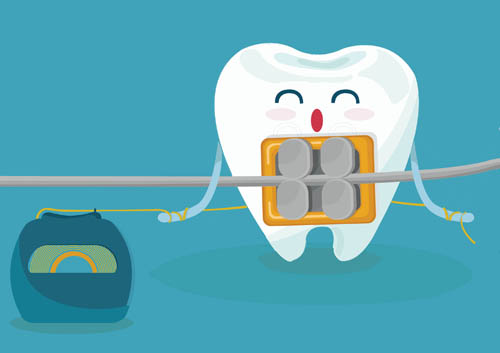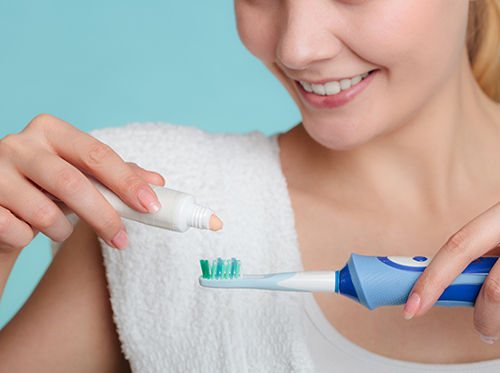
The Kamisugi Orthodontics team knows that oral hygiene is important, whether you have braces on your teeth or not. But if you are a person who wears braces, caring for your teeth and gums can become somewhat challenging. Without daily oral hygiene practices, you may become prone to cavities and tooth decay during your time in braces.
Naturally, you know that brushing your teeth each morning and night, as well as after you eat, will help keep your mouth healthy and clean during the months you wear braces. But flossing is also an important part of your hygiene routine. Flossing with braces can be tricky, but it’s not impossible. Dr. Curtis N. Kamisugi, your general dentist, or your dental hygienist can help you become more comfortable and adept at flossing your teeth during the months you wear braces.
Flossing Tips for Those with Braces
Continue Good Oral Hygiene Habits
Good oral hygiene habits you use while wearing braces will help you achieve the beautiful smile you and the Kamisugi Orthodontics team have been working toward. Once your braces are off, it may be tempting to slack off on the brushing and flossing. Don’t let yourself fall into any habits that will have a negative impact on your oral health or the attractive smile you waited for throughout the months you wore braces. See your general dentist for regular cleanings, and continue to brush and floss your teeth each day.

The electronic toothbrush has undergone several technological advances since the 1960s. Everything from design and bristle motions to rotation, oscillation, and sonic vibration has led to dramatic changes in this necessary tool over time.
Rotation oscillation happens when the head of the toothbrush rotates from one direction to the other. The benefit of powered toothbrushes is that they can produce 50,000 strokes per minute, compared to 300 strokes with a manual toothbrush.
When you’re thinking about brush head size, smaller brush heads are best for hard-to-reach areas and small mouths. Brush heads should be replaced every three to six months as needed. A good way to save money is to designate a brush head for each family member which can be taken on and off a shared base motor.
Having a base motor or rechargeable toothbrush can deliver enough power on a full charge for a week of brushing, which makes it convenient for travel or when life gets busy. Some toothbrushes include audible signals that let you know when to switch the area of your mouth you’re brushing or when a full two minutes has gone by.
Do you have sensitive teeth? Studies have indicated that people tend to apply more pressure on their teeth when they use a manual toothbrush. This makes an electric toothbrush a preferable option if you’re having issues with sensitive teeth or gums.
There are even electric models with pressure sensors that will stop the brush from spinning when you press too hard against your teeth!
Everyone can benefit from having an electric toothbrush. A large handle size can be taken into consideration if a member of the household is young, or has a physical disability or arthritis. They’re even recommended for children in order to maintain good oral hygiene from a young age.
Biofilm is a term used for plaque or debris that builds up in your mouth. If not properly addressed, this can cause serious bacterial infections to your gums and teeth. If you want to remove biofilm in the most efficient way, an automatic toothbrush is the way to go.
When you’re ready to make your decision, make sure to consult with Dr. Curtis N. Kamisugi at our Aiea, Hawaii office to decide which electric toothbrush is right for you!

After all your hard work, and months of orthodontic treatment, the big day is finally here—your braces are coming off! What you want to see: beautiful, straight teeth perfectly aligned to create a comfortable, healthy bite. What you don’t want to see: a collection of whitish spots dotting the enamel around your gum line or outlining the spot where your brackets used to be.
What are these spots? Can they be removed? And, most important, how do you avoid them?
Decalcification
Those white spots are caused by decalcification, or the removal of the minerals, especially calcium and phosphorus, that strengthen our enamel. How does this removal take place? When bacteria and plaque remain on the teeth, they produce acids that eat away at these minerals. The result is a weakened, discolored white spot in the enamel. Unfortunately, because many orthodontic patients don’t brush thoroughly around their braces, decalcification is an all-too-common problem.
Treating Decalcification
You might need cosmetic dentistry to eliminate or reduce white spots on the enamel. In some cases, they will fade over time, or teeth whitening can help. In more stubborn cases, tooth bonding or veneers can cover the affected enamel.
Preventing Decalcification
But, obviously, prevention is always better than treatment. Here are some of the ways to keep your enamel healthy and looking its best:
Getting rid of the bacteria and plaque on your enamel and around your gum line will greatly reduce your chances of decalcification—and cavities. Brush after every meal, and talk to us about the best products and techniques for cleaning your teeth and appliances. And be sure to spend the extra time you’ll need for brushing around your braces.
Even though it can be more difficult to floss with brackets and wires, it’s essential for removing plaque. We have suggestions for special flosses designed for braces wearers, and how best to use them. A water flosser can be helpful for reducing plaque if other flossing methods aren’t working.
Fluoride actually helps remineralize our teeth, replacing the important minerals that have been lost to acid attacks. We might also suggest remineralizing toothpastes or a fluoride rinse.
Acidic foods increase the acidity levels in your mouth, sugars give bacteria the fuel they need to produce acids, and sticky foods allow bacteria to remain on teeth and braces longer. We’ll give you suggestions on the best foods to keep your teeth healthy (and your braces intact) while you’re undergoing treatment.
Your dental professional will be able to remove plaque and tartar that home brushing has missed.
If we let you know that you need to spend more time on your cleaning routine, or that you need to be more thorough when you brush and floss, take our suggestions to heart. We are happy to show you the most effective way to clean around your braces. Dr. Curtis N. Kamisugi can recommend the best dental products for your specific needs. We can suggest rinses and toothpastes that will help. We’ll let you know how much time you should spend brushing and how often.
If you have any questions at all about keeping your teeth and braces their cleanest, we are here to help. Always feel free to talk to our Aiea, Hawaii team about concerns you might have about decalcification, discoloration, or any other potential problems. We are want to make sure that when your braces come off, you have every reason to smile!

Let’s talk science! From the vastness of the cosmos to sub-atomic particles, science helps us understand the world around us and how it works. So, let’s take some familiar scientific fields of study and apply them to your toothbrush.
My toothbrush?
Yes, indeed! When it comes to your oral health, your toothbrush is the first line of defense, so understanding how and why it works so well might help us use this handy tool even more effectively.
Biology—the study of living organisms
Unfortunately for your toothbrush, the living organisms we’re talking about here are the bacteria which cause tooth decay and those which can lead to illness. How do these problems arise, and how do we prevent them?
Fight Plaque
Plaque is the sticky film that builds up on teeth, and millions of oral bacteria help make up this biofilm. These bacteria convert sugars and other carbohydrates in the foods we eat into acids. And these acids erode our tooth enamel, leading to tooth decay. (More on this when we get to Chemistry.) The best ways to get rid of plaque?
Stop Germs from Spreading
Chemistry—the study of what makes up substances, their properties, and how they interact
When it comes to improving your brushing chemistry, the best thing you can do for your toothbrush is to put a dab of fluoride toothpaste on it! Why fluoride? Let’s look at the chemistry of tooth enamel.
Tooth enamel is the strongest substance in our bodies—even stronger than bone. But it is not indestructible, and acidic substances can dissolve the mineral bonds which give our enamel its strength, whether they come from the bacteria in plaque or are found in our favorite foods and drinks (sodas, coffee, tomatoes, and citrus are among the tasty, but acidic, culprits).
The enamel in our teeth contains calcium and phosphate ions, minerals which help make it the strongest substance in our bodies. But when the level of acidity in our mouths becomes too high, these minerals begin to dissolve. Eventually, teeth become pitted, bacteria can penetrate more deeply, and decay is the result.
So what can we do? While our saliva helps neutralize acidity naturally, and we can cut back on acidic foods in our diets, using fluoride toothpaste actually helps restore the strength of our enamel in a process known as “remineralization.”
Fluoride works on the surface of enamel to both attract and anchor calcium ions, reducing mineral loss and strengthening the weakened enamel. Fluoride also interacts with the calcium and phosphate compound to create a new compound that is even stronger and more acid-resistant.
When you brush with fluoride toothpaste, you help replace and restore the mineral composition of your enamel—and there’s evidence that fluoride might even interfere with oral bacteria’s ability to produce acid. Now that’s good chemistry!
Physics—the study of matter and energy and their interactions
The matter here is your tooth enamel, and the energy is the force you use when brushing. And this is one time the force should not be with you.
Brushing harder is not brushing better, and your teeth, gums, and braces will be heathier with careful brushing habits. If you need tips on brushing with braces, contact our Aiea, Hawaii office and ask!
There’s a lot of science in the simple act of brushing, but we don’t need to spend hours studying to get a passing grade in dental health. The things you do normally—brushing at least two minutes twice a day, using fluoride toothpaste, and applying proper brushing technique—will help create a smile which will earn you top marks from Dr. Curtis N. Kamisugi for a lifetime!